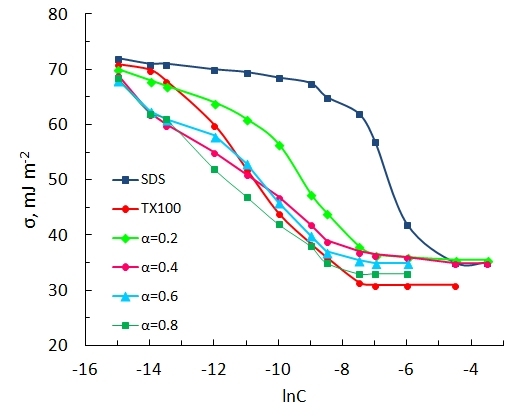Molecular Interactions in Binary Surfactant Solutions: Effect of Ionic Counterpart
DOI:
https://doi.org/10.29356/jmcs.v64i3.1153Keywords:
Triton X100, dodecylpyridinium bromide, sodium dodecyl sulfate, molecular interactions, mixed adsorption layerAbstract
Abstract. The effect of intermolecular interactions on processes of micelle formation and adsorption in binary mixtures of non-ionic Triton X100 (TX100) with ionic sodium dodecyl sulfate and dodecylpyridinium bromide surfactants was studied. The ionic surfactants have identical hydrophobic alkyl chain and different hydrophilic groups. A feature of the used binary surfactant mixtures is that critical micelle concentrations and surface activity of the individual components are considerably different. A synergetic effect of decreasing of the surface tension was found in the surfactant mixtures. It was shown that the mixed adsorption layers and the micellar phases are enriched with the nonionic surfactant. For both sodium dodecyl sulfate/TX100 and dodecylpyridinium bromide/TX100 systems, the synergetic effects were most pronounced at a high molar fraction of the nonionic surfactants in the mixture. By using the Ruben-Rosen model, molecular interaction parameters in the mixed micelles βm, and in the adsorption layers βσ were evaluated. As was shown βm and βσ parameters to be notably higher for sodium dodecyl sulfate/TX100 mixture.
Resumen. Se estudia el efecto de las interacciones intermoleculares en el proceso de formación y adsorción de micelas en mezclas binarias de Triton X100 (TX100), no iónico, con dodecil sufato de sodio y bromuro de dodecil piridinio, ambos iónicos, como surfactantes. Los surfactantes iónicos tienen cadenas alquílicas hidrofóbicas idénticas y grupos hidrofílicos diferentes. Una característica de las mezclas binarias de surfactantes que se utilizaron es que las concentraciones micelares críticas y la actividad superficial de los componentes individuales es considerablemente diferente. Se encontró un efecto sinérgico de decremento de la tensión superficial en las mezclas de surfactantes. Se muestra que las capas mixtas de adsorción y las fases micelares están enriquecidas con surfactante no iónico. Tanto en el sistema dodecil sufato de sodio/TX100 como en el caso de bromuro de dodecil piridinio/TX100, los efectos sinérgicos fueron más pronunciados en las mezclas con fracciones molares altas de los surfactantes no iónicos. Utilizando el modelo de Ruben-Rosen, se evaluaron los parámetros de interacción molecular en las micelas mezcladas βm y en las capas de adsorción βσ. Se muestra que los parámteros βm son βσ son notablemente mayores en la mezcla de dodecil sufato de sodio/TX100.
Downloads
References
Rosen, M.J. Surfactants and Interfacial Phenomena. Wiley-Interscience, New York, 2004 DOI: https://doi.org/10.1002/0471670561
Penfold, J.; Staples, E.J.; Tucker, I.; Thomas, R.K. Colloids Surf. A: Physicochem. Eng. Asp. 1999, 155, 11–26; DOI: 10.1021/la0002637 DOI: https://doi.org/10.1016/S0927-7757(98)00393-8
Rosen, M.J.; Zhou, Q. Langmuir. 2001, 17, 3532-3537. DOI: 10.1021/la001197b DOI: https://doi.org/10.1021/la001197b
Holland, P.; Rubingh, D., in Cationic Surfactants, Vol. 37, Holland, P.; Rubingh, D. (Eds.), Marcel Dekker, New York, 1991, 141-187.
Scamehorn, J.F., in: Phenomena in Mixed Surfactant Systems, ACS Symposium Series 311, Scamehorn J.F. (Ed.), ACS, Washington, DC, 1986, 1-27 DOI: https://doi.org/10.1021/bk-1986-0311.ch001
Janczuk, B.; Zdziennicka, A.; Wojcik, W. Colloids Surf. A: Physicochem. Eng. Asp.2003, 220, 61-68. DOI: 10.1016/S0927-7757(03)00060-8 DOI: https://doi.org/10.1016/S0927-7757(03)00060-8
Hua X.Y., Rosen M.J. Synergism in binary mixtures of surfactants. 1. Theoretical analysis. J. Colloid Interf. Sci. 1982, 90, 212-219. DOI: https://doi.org/10.1016/0021-9797(82)90414-3
Zhou, Q.; Rosen, M. J. Langmuir 2003, 19, 4555-4562; DOI: 10.1021/la020789m DOI: https://doi.org/10.1021/la020789m
Szymczyk, K.; Janczuk, B. Colloids Surf. A: Physicochem. Eng. 2007, 293, 39–50. DOI: 10.1016/j.colsurfa.2006.07.006 DOI: https://doi.org/10.1016/j.colsurfa.2006.07.006
Zdziennicka, A.; Szymczyk, K.; Krawczyk, J.; Janczuk, B. Fluid Phase Equil. 2012, 318, 25–33. DOI:10.1016/j.fluid.2012.01.014 DOI: https://doi.org/10.1016/j.fluid.2012.01.014
Wang, Y.; Marques, E.F.; Pereira, C.M. Thin Solid Films 2008, 516, 7458–7466. DOI: 10.1016/j.tsf.2008.03.029 DOI: https://doi.org/10.1016/j.tsf.2008.03.029
Geng, T.; Zhang, C.; Jiang, Y.; Ju, H.; Wang, Y. J. Mol. Liquids 2017, 232, 36–44. DOI: http://dx.doi.org/10.1016/j.molliq.2017.02.055 DOI: https://doi.org/10.1016/j.molliq.2017.02.055
Bakshi, M.S.; Singh, J.; Singh, K.; Kaur, G. Colloids Surf. A: Physicochem. Eng. Asp. 2004, 237, 61-71. DOI: 10.1016/j.colsurfa.2004.01.030 DOI: https://doi.org/10.1016/j.colsurfa.2004.01.030
Kochkodan, O.; Antraptseva, N.; Kochkodan, V. Material Science Forum. 2018, 936, 8-13. DOI: https://doi.org/10.4028/www.scientific.net/MSF.936.8
Javadian, S.; Kakeman, J. J. Mol. Liquids 2017, 242, 115–128. DOI: https://dx.doi.org/10.1016/j.molliq.2017.06.117 DOI: https://doi.org/10.1016/j.molliq.2017.06.117
Cirin, D.; Krstonosic, V.; Sazdani, D. Fluid Phase Equil. 2018, 473, 220-225, DOI: https://doi.org/10.1016/j.fluid.2018.06.009
Bagheri, A.; Paresa, K. RCS Adv. 2017, 7, 18151-18161. DOI: 10.1039/C6RA27382C DOI: https://doi.org/10.1039/C6RA27382C
Le, T.N.; Phan, C.M.; Nguyen, A.V.; Ang. H.M. Minerals Eng. 2012, 39, 255–261. DOI: http://dx.doi.org/10.1016/j.mineng.2012.06.003 DOI: https://doi.org/10.1016/j.mineng.2012.06.003
Adamson, A.W.; Gast, A.P. Physical Chemistry of Surfaces (sixth ed). John Wiley & Sons, Inc., New York, 1997.
Clint J.H. Micellisation of mixed nonionic surface active agents. J. Chem. Soc. Faraday Trans. 1975, 71, 1327-1334. DOI: 10.1039/F19757101327 DOI: https://doi.org/10.1039/f19757101327
Rosen, M. J.; Sultana, S.B. J. Colloid Interf. Sci. 2001, 238, 528-534. DOI: DOI:10.1006/jcis.2001.7537 DOI: https://doi.org/10.1006/jcis.2001.7537
Rusanov, A.I. Micelle formation in surfactants solutions. Khimiya, St. Petersburg, 1992
Moore, S.A.; Glenn, K.M.; MacDonald, A.M.; Palepu, R M. Colloid Polym. Sci. 2007, 285, 543-552. DOI: 10.1007/s00396-006-1604-6 DOI: https://doi.org/10.1007/s00396-006-1604-6
Maeda, H.J. J. Colloid Interf. Sci. 1995, l72, 98-105.
DOI: https://doi.org/10.1006/jcis.1995.1230.
Goloub, T.P.; Pugh, R.J.; Zhmud, B.V. J. Colloid Interf. Sci. 2000, 229, 72-81. DOI: 10.1006/jcis.2000.6954 DOI: https://doi.org/10.1006/jcis.2000.6954
Rozen, M.J.; Zhao, F. . J. Colloid Interf. Sci. 1983, 95, 443-452. DOI: https://doi.org/10.1016/0021-9797(83)90204-7


Downloads
Published
Issue
Section
License
Authors who publish with this journal agree to the following terms:
- Authors retain copyright and grant the journal right of first publication with the work simultaneously licensed under a Creative Commons Attribution License that allows others to share the work with an acknowledgement of the work's authorship and initial publication in this journal.
- Authors are able to enter into separate, additional contractual arrangements for the non-exclusive distribution of the journal's published version of the work (e.g., post it to an institutional repository or publish it in a book), with an acknowledgement of its initial publication in this journal.









